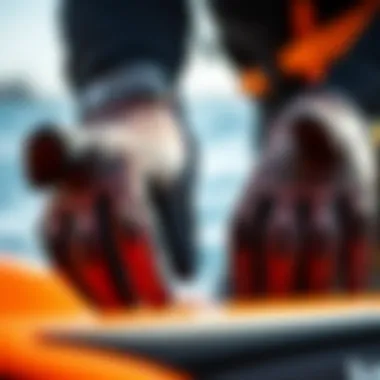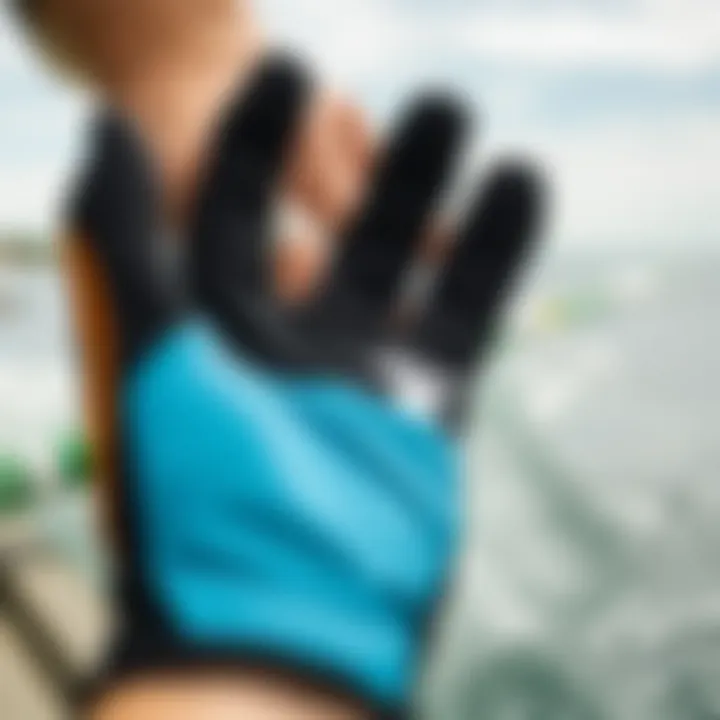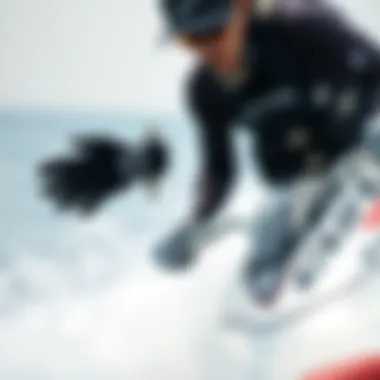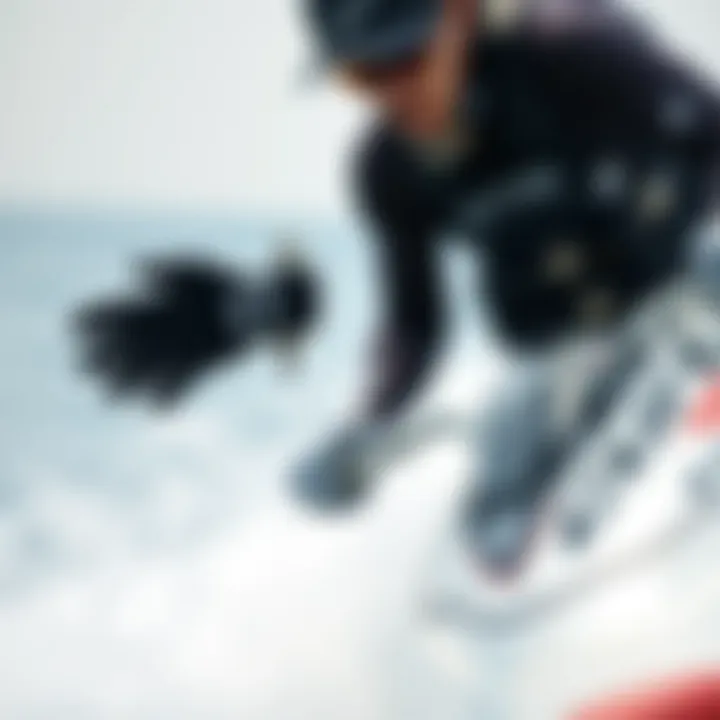Essential Insights on Curl Gloves for Watersports


Intro
In the realm of watersports, the right gear can make all the difference, especially when it comes to curl gloves. These specialized gloves are designed not just for aesthetics but to enhance performance and provide essential protection. Whether you’re slicing through waves or paddling in calm waters, understanding the functionality and benefits of curl gloves can significantly elevate your experience.
Understanding curl gloves involves unpacking their unique advantages in various watersports. This guide explores materials used, anatomical designs tailored for comfort and efficiency, as well as maintenance tips to prolong their lifespan. By delving deeper, we aim to provide you with the tools necessary to select the perfect pair that suits your individual needs, ultimately amplifying your performance on the water.
Expert Insights
Latest Trends in Watersports
In recent years, watersports have seen a surge in innovation, especially with equipment. Curl gloves are no exception. Manufacturers are turning to eco-friendly materials and advanced stitching techniques, resulting in gloves that are not only durable but also environmentally conscious. Some brands now incorporate breathable fabrics that allow for heat regulation during intense activities, enhancing comfort without compromising grip.
Furthermore, the trend of personalized gear has also taken root. Some companies offer customizable designs which let athletes express their unique style while ensuring they don’t skimp on functionality. Keeping an eye on such trends is crucial for enthusiasts looking to stay ahead of the curve.
Safety Protocols and Best Practices
While curl gloves serve a definitive purpose, ensuring safety while engaging in watersports is paramount. Proper fit and condition of gloves play an integral role in this. Tattered gloves can not only impair performance but lead to injuries as well. Here are some best practices to consider:
- Regular Inspection: Check your gloves for wear and tear. Small cracks or frayed edges can compromise grip.
- Choosing the Right Fit: Make sure gloves are snug but not overly tight. A good fit allows for dexterity while providing protection from scrapes and UV exposure.
- Pre-Activity Warm-Up: Just as you would warm-up muscles, ensure your hands and wrists are properly stretched and warmed up before engaging in intense activities.
"Being prepared and equipped appropriately can dramatically reduce the risk of accidents and enhance your enjoyment on the water."
Equipment Recommendations
Must-Have Gear for Beginners
If you are new to watersports, getting the right gear goes a long way in ensuring a positive experience. Besides curl gloves, here are some other essential items:
- Life Jacket: Safety comes first.
- Rash Guards: Protects skin from abrasion and UV rays.
- Board Shorts or Swimwear: Comfort is key when moving in and out of the water.
Advanced Equipment for Pros
For seasoned athletes looking to elevate their performance, consider advanced gear options:
- High-Performance Wetsuits: For cold water conditions, a proper wetsuit can maintain body temperature.
- Specialized Footwear: Depending on the sport, proper footwear can enhance grip and reduce fatigue.
- Advanced Curl Gloves: Look for features like reinforced fingertips or water-resistant materials.
For further reading, you might want to check out:
Foreword to Curl Gloves
Curl gloves are more than just a piece of gear; they are a pivotal element in enhancing performance and ensuring safety during various watersports. The increasing popularity of activities such as surfing, kayaking, and windsurfing has led to a heightened awareness of the importance of proper equipment. As participants engage in these thrilling pastimes, the right gear can make the difference between a great day on the water and an uncomfortable one.
Definition and Purpose
Curl gloves, at their core, are specially designed hand coverings that provide protection, grip, and control. These gloves are typically made from materials such as neoprene, latex, or synthetic blends, depending on the intended use. Their primary purpose is to enhance the user’s performance by improving grip on equipment, reducing fatigue, and protecting the hands from cuts, scrapes, and the elements. The snug fit offered by curl gloves also aids in maintaining dexterity, allowing for better handling of paddles, sails, and boards. In a nutshell, these gloves serve a crucial role in optimizing a watersport enthusiast's experience.
Historical Context
The use of gloves in watersports isn't a new notion. Historically, seafaring crews used rudimentary hand coverings to protect themselves during long voyages and rough weather. In fact, one could look back as far as the 19th century, when fishermen would don heavy gloves to aid in handling ropes and nets. As watersports evolved, so did the concept of specialized gloves. With the development of advanced materials and manufacturing processes in the late 20th century, curl gloves began to emerge as a distinct category, tailored specifically for activities like surfing and kayaking. Nowadays, these gloves have come a long way from their earliest incarnations, incorporating cutting-edge technology that amplifies functionality while also catering to individual preferences in style and fit. This historical evolution underscores the increasing understanding of how critical hand protection and grip can be to engage in watersports safely and effectively.
Materials Used in Curl Gloves
Understanding the materials used in curl gloves is crucial for anyone interested in watersports. Each material brings its own set of advantages and shortcomings, influencing everything from grip to durability under various conditions. In these demanding environments, the right material can enhance performance significantly and reduce the risk of injury. Moreover, materials contribute to the comfort level, which is vital for prolonged use on the water.
Neoprene
Neoprene is perhaps the most common material employed in curl gloves, primarily due to its exceptional insulating properties. This rubber-like substance keeps your hands warm in cold waters, which is paramount for activities like surfing or kayaking. Not only does neoprene provide insulation, but it also offers a good amount of flexibility, allowing for a natural range of motion.
The thickness of neoprene can vary, affecting both warmth and dexterity. For instance, a thicker glove may offer better protection but could compromise the tactile sensitivity needed to grip a paddle or board effectively. As a rule of thumb, choosing the right thickness should depend on the water temperature and the type of activity you plan to engage in.
Some potential downsides include its vulnerability to tearing and degradation in prolonged sunlight. Thus, keeping the gloves in a dry bag when not in use can serve as a smart preventive measure.
Latex


Latex may not be as commonly recognized for curl gloves, but its lightweight and stretchable qualities make it an attractive option for some users. The primary benefit of latex is its superior grip, which comes in handy when precision is necessary, such as when holding onto a kayak paddle. This grip can improve overall handling, making it easier to respond to unpredictable water conditions.
One of the downsides to latex is its susceptibility to punctures, so care is needed when using it in rocky or abrasive environments. Additionally, some individuals might experience allergic reactions to latex, creating an important consideration during the selection process. To avoid issues, make sure you check the ingredients thoroughly before purchasing.
Synthetic Blends
Synthetic blends represent a compromise, gathering the best characteristics of various materials to enhance performance. These gloves often employ a mix of neoprene, polyester, and plastic-based foams, which result in a combination of warmth, flexibility, and durable performance.
One notable advantage of synthetic blends is their resistance to wear and tear. This makes them particularly valuable for frequent users who subject their gear to demanding conditions. They also tend to dry more quickly than traditional neoprene, reducing discomfort after a session in the water.
However, they can be less environmentally friendly compared to natural materials. As more brands adopt sustainable manufacturing practices, finding eco-friendly synthetic blend options is becoming increasingly feasible.
Choosing the right material is more than just a preference; it can significantly impact your performance and comfort on the water.
In summary, the right material can make a world of difference when it comes to curl gloves. Each option, be it neoprene, latex, or synthetic blends, presents unique benefits and limitations that need careful consideration. Understanding how these materials perform in various conditions will allow athletes, coaches, and recreational enthusiasts to make informed choices for their specific watersport activities.
Anatomical Design and Fit
The anatomical design and fit of curl gloves are crucial aspects that can greatly influence performance in various watersports. Understanding how curl gloves are crafted to accommodate the natural contours of the hand is essential. A well-fitted glove not only enhances comfort but also maximizes control, leading to better outcomes during activities such as surfing, kayaking, and windsurfing.
Ergonomic Shapes
When selecting curl gloves, one of the key factors to consider is the ergonomic shape. Ergonomics refers to the science of designing products to fit the needs of users, in this case, the unique shape of human hands. Curl gloves that are designed with an ergonomic focus often feature pre-curved fingers and a fitted palm. By mimicking the natural hand position, these gloves allow for more efficient movement and less fatigue.
The advantages of choosing ergonomic gloves cannot be overstated. They not only prevent discomfort during extended use but also facilitate quicker reactions while maneuvering equipment. For instance, when a paddler is gripping a kayak paddle, an ergonomic glove enhances the sensitivity of each stroke while reducing the risk of cramping. The design enables users to maintain a firm grip for longer periods without experiencing pain or strain in the hands.
Size and Measurements
Size and measurements play a pivotal role in ensuring that curl gloves fit correctly. Ill-fitting gloves can hinder performance and lead to a range of issues such as reduced grip and dexterity. To get the perfect fit, one needs to measure the length of the hand from the tip of the longest finger down to the base of the palm.
Following that, measuring the circumference around the palm can further assist in identifying the right size. Different brands have varying size charts, so it’s important for athletes to refer to these specific guides rather than relying solely on their typical glove size.
"Getting the right size glove is like finding a needle in a haystack; it can be tricky but essential for optimal performance."
Many stores and online retailers offer tools or guides for your convenience. In some cases, they even have fit testers available so customers can ensure they find a glove that feels like a second skin. Remember, a snug fit should be complemented by enough flexibility to allow for natural hand movement.
Grip and Flexibility
Grip and flexibility are two sides of the same coin that truly define the effectiveness of curl gloves in watersports. A glove should not only fit well but also provide optimal grip on any gear being used, whether it’s a surfboard or a paddle. The materials and textures used on the palm often determine this feature.
Look for gloves that incorporate specialized gripping materials, such as silicone prints or textured rubber, which enhance traction especially in wet conditions. It is also essential for these gloves to possess a certain degree of flexibility to allow for quick hand movements and adjustments. If a glove is too rigid, it may restrict performance and lead to accidents.
The balance between grip and flexibility allows athletes to perform complex maneuvers effortlessly. For instance, in kayaking, a firm grip on the paddle is necessary for effective strokes. Hence, curl gloves deliver the right amount of stickiness without sacrificing mobility.
In summary, the anatomical design and fit of curl gloves significantly affect their functionality in watersports. Understanding ergonomic shapes, ensuring correct size and measurements, and prioritizing grip and flexibility can lead to a noticeable improvement in both performance and comfort. Whether you're a seasoned pro or a weekend warrior, investing time in the right selection process pays dividends on the water.
Advantages of Using Curl Gloves
Curl gloves offer a unique fusion of utility and performance enhancement for those engaged in watersports. Their benefits go beyond mere aesthetics, acting as crucial tools that enhance the overall experience on the water. With a focus on three prominent advantages—improved grip and control, protection from environmental factors, and injury prevention—this section will explore why these gloves are indispensable for athletes, coaches, and recreationists alike.
Improved Grip and Control
One of the primary reasons athletes opt for curl gloves is the improved grip they provide. Without a solid grip, maneuvering equipment—be it a surfboard or a kayak—becomes akin to trying to hold onto a greased pig. Curl gloves are typically designed with textured surfaces that enhance traction, offering reliable control in wet conditions. Whether you’re gripping a paddle or steering a windsurfing sail, this improved grasp allows for more responsive and confident handling.
Imagine trying to catch a wave only to have your hands slip, sending your board sliding away. That extra layer of material can make or break your performance. A good pair of curl gloves doesn’t just cushion your hands; they become an extension of your body, providing an unyielding connection to your gear. As a result, your movements become more fluid, adaptive, and precise, translating into better performance on the water.
Protection from Elements
Watersports enthusiasts often find themselves battling various elements—sun, wind, and water temperatures can all take a toll. Curl gloves act as a barrier not only against cuts and scrapes but also the bone-chilling effects of cold water and harmful UV rays. For instance, extended exposure to cold temperatures can lead to numbness in hands, compromising your ability to grip effectively. Curl gloves help insulate your hands, maintaining warmth and dexterity.
Moreover, the sun’s glare can be a real nuisance, affecting visibility and focus. Some curl gloves come with UV-resistant materials that shield your skin, reducing the risk of sunburn during long sessions. As the saying goes, "an ounce of prevention is worth a pound of cure." Investing in a good pair of curl gloves ensures that you're protected against the elements, allowing you to focus solely on your performance, not on your discomfort.
Injury Prevention
Injuries can derail an athlete's passion for watersports quicker than one can say "wipeout." Curl gloves provide essential protection against blisters and abrasions, particularly during intense activities. Even small discomforts can escalate into bigger issues over time, affecting performance and enjoyment.
These gloves also support the wrist joint, which can be crucial for preventing repetitive strain injuries. For instance, during paddling activities or maneuvers in surfing, the wrist takes on considerable strain. By providing cushioned support, the gloves can help alleviate pressure, allowing for longer, more comfortable sessions.


"Prevention is better than cure" is a mantra that resonates with many athletes. Curl gloves not only shield from immediate physical harm but also contribute to long-term well-being, letting enthusiasts pursue their passions without the looming threat of injury.
Texture, warmth, and support—curl gloves pack plenty of advantages that make them an invaluable companion for anyone stepping out onto the water. Understanding these benefits is essential when considering the right gear, ultimately elevating your performance and enjoyment across different watersports.
Choosing the Right Curl Gloves
Selecting the appropriate curl gloves is pivotal for enhancing performance in various watersport activities. The right pair can mean the difference between a great day on the water and a frustrating one. Curl gloves are more than just an accessory; they serve specific purposes that cater to individual needs in distinct environments. Given the diversity in water activities, it's essential to consider a few key elements to make an informed decision.
Assessing Water Activities
When it comes to curl gloves, one size doesn't fit all. Different water activities require specific features from your gloves. For instance, if you're a surfer, you'll need gloves that offer superior grip and tactile sensitivity to maintain control on the board. In contrast, a kayaker might prioritize insulation to combat colder water temperatures.
- Surfing: Look for gloves with a good grip and flexibility, allowing seamless movement of fingers. The gloves should also be thin enough for maximum tactile feedback while paddling.
- Kayaking: Opt for thicker, insulated gloves that ensure warmth without sacrificing dexterity. The gloves should also provide protection against wind and water exposure.
- Windsurfing: Ventilation becomes critical here, so lightweight and breathable gloves that retain grip without overheating are ideal.
By seriously evaluating the specific demands of your chosen water sport, you can make a more targeted selection of curl gloves to enhance your experience.
Personal Preferences
Personal preference plays a substantial role in choosing the right curl gloves, as comfort and fit can directly affect performance. Each person has unique requirements based on their hands' shape and size. Here are a few points to consider:
- Fit: Some people prefer a tighter fit for more responsiveness, while others may want a looser fit for comfort. Don't hesitate to try on different gloves before buying.
- Finger Length: Some gloves come with full fingers, while others have fingerless designs. Think about which style you find more comfortable when participating in your sport.
- Color and Design: While functionality should come first, the aesthetic appeal shouldn’t be ignored either. Your gloves can reflect your personal style, creating a good balance between utility and flair.
Finding a pair of curl gloves that aligns with your specific preferences can significantly impact your enjoyment level when engaging in watersports.
Budget Considerations
While pursuing the perfect pair of curl gloves, budget constraints can also weigh heavily on your decision. High-end gloves often come with cutting-edge materials and features, but there are mid-range options that provide excellent performance without breaking the bank. Here’s how to approach budgeting:
- Set a Range: Determine how much you’re willing to spend before you start shopping. This helps narrow down your options.
- Research: Look for reviews and comparisons across various price points. Sometimes spending a bit more leads to significant benefits down the line, particularly in durability and performance.
- Sales and Discounts: Keep an eye out for seasonal sales or offers from manufacturers. You just might snag a deal on a top-quality pair of gloves.
In the end, while it’s tempting to splurge on the latest models, balancing quality and cost is crucial.
Choosing the right curl gloves can dramatically affect not just your performance but also your safety and comfort on the water. Don’t rush the process; find what works best for you!
Maintenance and Care for Curl Gloves
Proper maintenance and care of curl gloves are integral for maximizing their lifespan and ensuring optimal performance in all types of watersports. Just like any sports equipment, neglecting them could lead to decreased efficacy and safety risks. Taking the time to understand how to clean, store, and monitor the condition of your gloves makes a significant difference in how well they perform on the water.
Cleaning Techniques
Keeping curl gloves clean is paramount to maintaining their functionality. Saltwater and fresh water can leave residues that not only wear down the material but also encourage the growth of unwanted bacteria.
To clean your curl gloves effectively, follow these steps:
- Rinse Immediately: After each use, rinse the gloves thoroughly in fresh, clean water to remove salt and dirt. This step is crucial; otherwise, your gloves could develop an unpleasant odor.
- Soak and Scrub: For deeper cleaning, soak the gloves in a mild detergent solution for about 10-15 minutes. After soaking, gently scrub with a soft brush to remove any stubborn particles.
- Rinse Again: Make sure to rinse the gloves exhaustively under running water to eliminate any soap residue.
- Air Dry: Never use heat sources like radiators or hairdryers. Instead, hang them up to dry naturally in a shaded area to maintain the glove’s elasticity and prevent cracking.
These techniques work wonders to keep your gloves in shape. It may seem like a hassle now, but taking these steps will pay off in the long run.
Storage Recommendations
How you store your curl gloves when you’re not using them can be the difference between longevity and early replacement. Proper storage helps prevent deformity and material degradation. Here are some storage tips:
- Cool, Dry Place: Store your gloves in a cool and dry location. Avoid exposing them to direct sunlight or extreme temperatures, as excessive heat can warp their shape.
- Avoid Compression: Don’t fold or stack other equipment on top of the gloves. This could lead to creases and reduce their flexibility.
- Use a Hanging Method: If possible, hang your gloves on a hook. This practice can help retain their shape and keep them free from dirt or moisture.
Adopting these storage practices can greatly enhance your gloves' operating lifespan and protect your investment.
Signs of Wear and Tear
Every athlete dreads losing their gear at the time when they need it most. Keeping an eye out for signs of wear and tear ensures that your curl gloves remain effective and safe to use. Here are some indicators:
- Visible Cracks or Holes: Any signs of serious damage should alert you to either repair or replace your gloves promptly. Holes can weaken the glove and lack of integrity exposes you to injuries.
- Fading Color: A loss of color often signifies that materials are deteriorating. This can indicate that your grips may wear out more quickly than expected.
- Loss of Elasticity: If the gloves feel loose or don't snugly fit your hands anymore, it's likely time to consider a new pair. A proper fit is critical, especially in activities that require great precision.
Keeping your eyes peeled for these signs can save you from potential mishaps out on the water, ensuring your performance isn't compromised.
Curl Gloves in Different Watersports
Curl gloves play a pivotal role across various watersport activities, enabling participants to enhance their performance and ensure safety. From surfing to kayaking and windsurfing, the environment demands a lot from athletes. The right pair of curl gloves serves to provide both support and protection, allowing users to focus on their technique and enjoyment, rather than grappling with equipment issues. Picking the optimal gloves can make a significant difference in grip, comfort, and overall experience on the water.


Surfing
In surfing, curl gloves are often seen as a crucial element for many, especially in colder waters where maintaining warmth is essential. These gloves not only provide thermal insulation but also enhance grip on the board. Surfers often find their hands slipping when trying to paddle out through waves. Curl gloves with textured palms help maintain a solid hold, ensuring that every wave is met with control.
In terms of material, many surfers opt for gloves made from neoprene due to its ability to wick away water while keeping hands warm. This particular fabric also offers flexibility, which is key when trying to perform tricks or maintain balance on a board. As a bonus, they protect against the surfboard’s rough edges, reducing the chances of cuts or abrasions.
Kayaking
Kayaking, whether it's a calm river or a raging sea, calls for precise hand movements. Curl gloves here serve a dual purpose: they enhance grip on the paddle and provide protection from the elements. Paddlers exert a force on their gear that can lead to fatigue, and the right gloves can minimize this by reducing slippage and improving grip.
Furthermore, the water conditions can often be unforgiving. Materials like latex provide a tight fit, preventing water from entering while still allowing for dexterity. When navigating through turbulent waters, having that extra control in one's grip can be the difference between a smooth journey and a tough battle against the elements.
Windsurfing
Windsurfing is quite technical, requiring a balanced act of wind control and physical movement. Here, curl gloves serve to keep everything stable. The wind can be relentless, and without the right grip, sails can slip, making control challenging. Gloves with reinforced palms are favored by windsurfers to prevent tearing and add stability when holding the sail. They act as an extension of your hand, enabling intricate maneuvers with ease.
In addition to grip, comfort is paramount in windsurfing. With potential hours spent on the water, gloves that fit well and breathe adequately are non-negotiable. Customization can also play a big role; one-size-fits-all doesn't always cut it in the sport, as different styles may require different fits.
"A well-fitted curl glove is like a second skin, allowing athletes to excel without restriction or discomfort."
Overall, whether it’s surfing, kayaking, or windsurfing, curl gloves enhance an athlete’s capabilities while ensuring safety and comfort. With thoughtful choices based on specific activities, participants can truly elevate their experience on the water.
Future Trends in Curl Glove Development
The world of curl gloves is constantly evolving, forged by advancements in technology, shifts in environmental consciousness, and the demands of watersport enthusiasts. For those deeply engaged in activities such as surfing, kayaking, or windsurfing, understanding these trends can enhance not only performance but also sustainability. This section examines the essential trends that are paving the way for the future of curl gloves, encompassing key areas like technological advancements, sustainable materials, and customization options.
Technological Advancements
As with many athletic gear, curl gloves are benefitting from leaps in technology. From materials to functionality, innovations are making these gloves more effective and user-friendly. Some noteworthy advancements include:
- Smart Technology Integration: Some manufacturers are incorporating smart technology into their gloves. For instance, gloves with built-in sensors can track grip strength and alert users to any changes in technique.
- Enhanced Breathability: New fabrics with improved breathability keep hands cooler and dryer during intense activity. This is essential in preventing chafing and blisters, ultimately enhancing user comfort.
- Water-Resistant Coatings: Coatings that repel water while maintaining flexibility are becoming more common, providing better performance in wet conditions. This feature alone elevates the gloves' standing in various watersport activities, making them not just protective but also functional.
These advancements are not merely trends; they are game changers, allowing athletes to push their limits further than before while minimizing the risk of injury.
Sustainable Materials
The conversation around sustainability is no longer just a trend; it's essential in every facet of manufacturing, including watersport gear. Consumers are becoming increasingly aware of their ecological footprints, and brands are responding accordingly. Evolving trends in curly gloves now emphasize:
- Eco-Friendly Materials: Brands are investigating plant-based alternatives to traditional materials. For example, gloves with natural rubber or recycled materials are gaining traction.
- Longevity and Durability: Manufacturers are focusing on creating gloves that last longer, reducing waste. High-quality stitching and materials help eliminate the need for frequent replacements, which aligns with eco-conscious values.
- Biodegradable Options: Some innovative companies are experimenting with biodegradable materials that will naturally decompose over time, reducing landfill contributions.
With these sustainable practices, watersport enthusiasts can enjoy their activities while also fostering environmental responsibility, making a positive impact on the planet.
Customization Options
The ability to personalize gear has become a hallmark of modern athletic equipment, and curl gloves are no exception. Customization options are increasingly prominent, enabling users to have a product that reflects their individual style and meets their specific needs. Here are a few areas where customization is gaining ground:
- Fit and Size: More brands are beginning to offer tailored fits, allowing users to select specific sizes and shapes according to hand dimensions. This not only ensures comfort but enhances grip and performance.
- Color Choices: The days of one-color-fits-all are behind us. Many manufacturers now offer vibrant colors and patterns, enabling enthusiasts to express personal style while remaining functional.
- Technology Features: Some brands offer selectable features such as enhanced grip textures or specialized padding to cater to different activities, ensuring that each pair of gloves serves a unique purpose.
Customization extends the lifespan of the product because users feel a greater attachment to something that reflects their personal style and preferences.
In summary, the direction in which curl gloves are headed is exciting and diverse. With innovation at the forefront, upcoming trends are set to make watersport activities safer, more enjoyable, and beneficial for the environment.
The End
The discussion of curl gloves within the realm of watersports is key for anyone involved, be it athletes looking to boost their performance or hobbyists seeking a more enjoyable experience. Curl gloves aren’t just hand protection; they're essential tools that can elevate safety and functionality across various activities like surfing, kayaking, or windsurfing. Understanding their features, materials, and benefits leads to informed decision-making, ultimately enhancing performance on the water.
Recap of Key Points
In this article, we’ve navigated through a myriad of essential aspects regarding curl gloves, including:
- Definition and Purpose: They serve not only for grip but also for weather protection.
- Materials: Options like neoprene and synthetic blends offer different advantages suited for specific conditions.
- Anatomical Design: Ergonomic shapes benefit hand movements, while proper sizing ensures comfort.
- Advantages: Improved grip and injury prevention were highlighted as major benefits.
- Choosing the Right Gloves: Assessing activities, personal preferences, and budget plays a pivotal role.
- Maintenance: Knowing how to care for and identify wear can prolong the life of your gloves.
- Future Trends: The industry seems to be leaning towards sustainable materials and tech advancements which could shape the future of curl gloves.
Final Thoughts on Curl Gloves
Curl gloves are not merely accessories for watersports enthusiasts; they are game-changers. By understanding their nuances, potential buyers can make choices that not only enhance their grip and performance but also protect them against the elements. Investing in the right curl gloves contributes to a safer and more enjoyable watersport experience. As technology and material science advance, the gloves of tomorrow promise to be even more aligned with the specific needs of each sport. Staying informed about these evolving trends ensures that users can maximize their enjoyment and safety on the water.
"The right gear doesn’t just make a difference; it can redefine your relationship with the water."
For more information on enhancing your watersport experiences, check out these resources:
- Wikipedia on Watersports
- Britannica on Curl Gloves
- Reddit community discussions on Curl Gloves
- Safety guidelines for watersports athletes
Choosing the right curl gloves is an investment in your performance and safety; don't overlook this crucial piece of your watersport gear.







